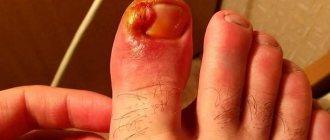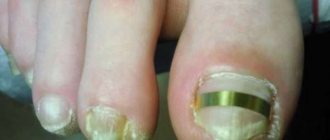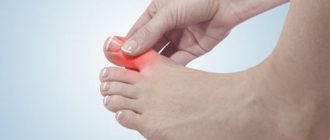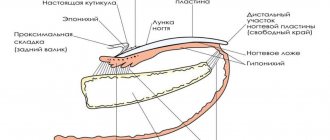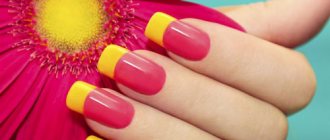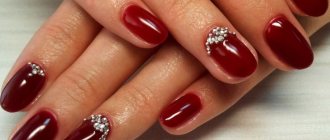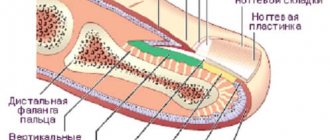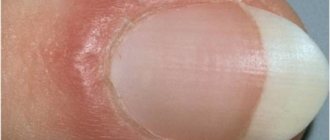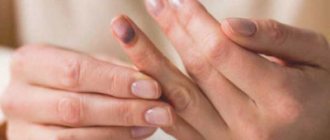From this article you will learn:
- What are the causes of ingrown nail plates?
- What are the methods for removing an ingrown toenail?
- How to remove an ingrown toenail using surgical and radio wave methods
- Is laser removal of ingrown toenails painful?
- How to avoid ingrown toenail removal
- How much does it cost to correct an ingrown toenail in Moscow?
Many people have experienced the disease of ingrown toenails, because almost a third of people suffer from onychocryptosis. This is the name of this problem when the nail plate cuts into the skin and causes inflammation, deformation of the nail, acute pain and suppuration of the skin. Both hands and feet are susceptible to this, but most often, of course, the big toes suffer from this disease. There are different ways to solve this problem, including removing the ingrown toenail or correcting it.
Ingrown toenail: causes of the disease
The lateral edge of the nail fold is injured by an improperly growing nail. A wound appears on the finger, which very often gets infected, causing inflammation. This is onychocryptosis. This problem cannot be solved independently with baths and steaming; it is necessary to remove the entire nail or part of it.
The symptoms of an ingrown toenail are familiar to many: the skin on the finger becomes red and swollen, pain occurs both when moving and at rest.
Causes of ingrown toenails:
- Irregular shape of the nail, an attempt to make a rounded shape often leads to too much cutting of the corners of the nail plate;
- Pressure shoes or boots, narrowed toes;
- Deformation of the nail plate due to fungal infection;
- Hereditary changes;
- Bumps or bruises of the fingers when the nail fold is injured;
- Obstructed blood flow in the vessels of the fingers, which is often found in diabetes.
In diabetes, an ingrown toenail is a more serious problem than in all other cases. It is necessary to pay very close attention to this, because the regeneration process of the skin is disrupted, and everything takes a long time to heal. If onychocryptosis is not treated, it can turn into gangrene, which can lead to surgery to remove the finger. Therefore, if you suffer from diabetes, seek medical help immediately as soon as you notice the first signs of an ingrown toenail.
Why do nails grow in?
When wearing narrow shoes with high heels, the forefoot is subjected to heavy load. If these factors influence for a long time, a hallux valgus deformity may occur. It becomes bent and a lump forms on the outside, which increases the likelihood of acquiring onychocryptosis. In addition to improperly selected shoes, the causes of onychocryptosis can be:
- genetic predisposition;
- improper cutting of the nail plate;
- toe injuries;
- excess weight;
- professional activity;
- some diseases.
Some professions require a person to be on his feet for a long time. Inconvenient, incorrectly selected shoes can provoke the formation of onychocryptosis. This disease may be a consequence of diabetes mellitus due to impaired blood circulation and insufficient work of the leg muscles. The nail plate is easily injured in diabetes mellitus, and microcracks that form on the skin take a long time to heal. Excess weight can aggravate this problem because the pressure on the legs increases, leading to swelling of the limbs.
With flat feet, the tendons are weakened, which causes the muscle tissue of the legs to sag. This position of the foot leads to additional stress on it and increased pressure on the toes, often provoking onychocryptosis. Fungal diseases of the feet often cause infection of the skin of the nail fold. Nail plates affected by fungus peel, become deformed and often deepen into the skin on the big toe, less often on the other toes. There are cases of this disease on the little toes and fingers of the upper extremities.
Ingrown toenail: treatment and removal
If pain occurs, it is necessary to show the ingrown nail to a doctor so that he can determine the degree of ingrowth, whether there is a need for removal, and whether it is possible to remove only part of the ingrown nail while preserving the plate as a whole, and also check the condition of the remaining nails.
Most often it is necessary to remove nails on the big toes. If the ingrown toenail is caused by a fungal infection, you will have to undergo additional examinations:
- General tests to check the condition of the body (blood and urine).
- Bacterial tests to determine what type of fungus is causing the nail lesion and to prescribe the correct treatment.
- Allergy tests are necessary to relieve a possible allergic reaction of the body to painkillers that are used during laser surgery to remove an ingrown toenail.
If the process is in an advanced state, then an x-ray will also be needed to see if the bone tissue is affected. In case of inflammation of the finger or suppuration of the nail folds, it is necessary to first cure the infection that caused the inflammatory reaction, after which it will be possible to remove the ingrown nail. Only a doctor can determine what exactly caused the inflammation and prescribe the appropriate medications. Antifungal treatment may be required, necessarily anti-inflammatory and antiseptic. In the most severe cases, when a bacterial infection is detected, a course of antibiotics is prescribed. When the inflammation is cured, you can begin to remove the ingrown toenail.
Causes
Deformation of the plates on the lower extremities can be of the following types:
- surface curvature;
- structure delamination;
- nail loss or ingrowth into the skin;
- overgrowth of the plate with cuticle;
- hardening, compaction and increase in nail thickness.
More often the deformation is associated with:
- disease of internal organs;
- bacterial or fungal infection;
- anemia;
- hormonal imbalance;
- mechanical damage;
- improper care (lack of hygiene, abuse of varnish, frequent extensions);
- wearing the wrong shoes.
Predisposing factors include an unbalanced diet, taking certain medications that lower the immune system and disrupt the microflora, both local and general. If the disease of the nail plate is hereditary, then most often this case cannot be treated.
Infectious lesion
Bend toenails can also be caused by improper care or fungal diseases, manifested by itching between the toes and on the feet. Characterized by the presence of cracks, discomfort, and excessive sweating of the lower extremities.
First, the surface of the plate changes, then the entire structure is affected and deformed.
The list of diseases in which nails begin to deform:
- Mycosis. The causative agent is a filamentous fungus.
- Candidiasis. The disease is caused by the Candida fungus.
- Onychomycosis. Pathogen of the genus Trichophyton, Microsporum, Epidermophyton. This pathology is characterized by a change in the color of the nail and its fragility. When the purulent form is attached, a gray mass with an unpleasant odor is observed.
- Fungal epidermophytosis. The causative agents are epidermophytons.
Bacterial and fungal infections are most often associated with visiting public places and becoming infected from a sick person. But upon contact with a carrier, infection does not always occur; this is due to the strength of the immune system. Young children are more susceptible to such problems.
An infection can develop due to poor hygiene or frequent nail extensions. When the top layer of the plate is cut off, the nails become fragile and are easily susceptible to penetration by pathogenic microorganisms.
Deformation due to diseases
Deformation of the plate due to nail disease is not a common manifestation, however, folding inward can occur when:
- Koilonychia. The plates resemble the shape of a spoon. In children it can be a physiological feature and go away on its own.
- Hippocratic nails. The disease may be associated with pathological processes in the heart, liver, and lungs. Nails take on a rounded shape.
- Bird's claw. The plate thickens, bends, and curls into a tube. Usually develops after injury.
- Ptergia, when the cuticle tightens the surface of the plate, which bends inward.
Physiological reasons
Curling or ingrown toenails may be caused by wearing uncomfortable shoes. This is usually typical for models with narrow toes, when all the toes are compressed, which causes deformation of the plate.
Mechanical damage can occur both when wearing tight shoes and independently. A strong blow or a heavy object falling on the foot can cause changes in the structure of the nail.
Hormonal imbalance also increases the risk of problems.
Lack of vitamins
Sometimes deformation is associated with poor nutrition and strict diets. If the body does not receive enough necessary vitamins and nutrients, then the plates begin to thin out, break, flake, curl, bending down, up, and to the sides.
For proper growth, not only calcium is important, but also chromium, phosphorus, iron, vitamins A, C, B.
Vitamin deficiency can occur even with a balanced diet.
The main reason for this is a violation of metabolic processes, incomplete absorption of necessary substances.
This happens when the functionality of the digestive, endocrine system, or various chronic pathologies in the body is impaired.
What are the methods for removing an ingrown toenail?
- Surgical removal of an ingrown toenail: the most common operation that will be performed in public clinics. With it, the removal of the nail occurs mechanically; it will not be possible to save part of the nail plate. This is a very painful operation with a long recovery period. After removing the nail plate, the open wound is treated with an antiseptic and bandaged. The average prices for the operation do not differ much from other, less traumatic methods and start from 2.5 thousand rubles.
- Radio wave removal of ingrown toenails: the Surgitron device is a radio wave knife used to perform operations to remove ingrown toenails. This method allows you to save most of the plate, cutting off only the damaged one. The radio wave acts purposefully, contactlessly and effectively. Local anesthesia allows the removal to be carried out absolutely without pain; you only have to endure the anesthetic injection itself. The wound will heal in the next two weeks and will no longer bother you, and complete recovery will occur in three months. The cost of this operation on average starts from 3.3 thousand rubles.
- Laser removal of ingrown toenails: Laser removal of ingrown toenails is the most gentle method and has a much shorter healing period. The laser beam, removing part of the nail plate that has grown into the nail fold, cauterizes the capillaries, reducing bleeding, relieves inflammation of the skin around the ingrown nail and accelerates regeneration processes. Therefore, the recovery period takes much less time than other methods, and also reduces the possibility of a similar problem reoccurring. The price for removing an ingrown nail with a laser starts from 2.5 thousand rubles.
Treatment methods
The self-confidence of patients reaches a critical point when independent attempts to cope with the disease lead nowhere.
The hand hurts so much that any movement of it is difficult .
Seeing a doctor is the best decision in this case.
Only a specialist will be able to advise and show how treatment measures are carried out correctly at home.
And it is the doctor who makes the decision to hospitalize the patient if his condition gives rise to serious concerns.
Features of home treatment
Therapy at home gives positive results if the disease is at an early stage.
The patient receives recommendations for procedures from the attending physician. Treatment occurs in several stages:
- Hands must be washed thoroughly.
- Soft tissues and the nail layer need to be softened using baths.
- The ingrown edge of the nail is released and carefully removed .
- A gauze turunda soaked in antiseptic solutions or ointments is placed under the nail .
- to the finger and hand .
The water in the baths is diluted with soda, tar soap, furatsilin, potassium permanganate, Chlorhexidine. To treat the affected area, Levomekol, Streptocide, and Vishnevsky ointment are used.
If it is not possible to free the entire ingrown piece of nail in one go, then the procedure is repeated several times.
What does traditional medicine offer?
Treatment with traditional recipes is allowed in conditions where the integrity of the skin is not compromised and the development of an abscess has not begun. The following recipes are used:
- lemon zest and vegetable oil (olive or sunflower) in an amount of 1:2 Moisten a cotton swab, apply to the sore spot, and secure with a bandage.
- Pick a few aloe leaves , free them from the skin, chop the pulp and put fresh pulp from the plant on your finger. Wrap the top with cling film and secure with a bandage.
- It also relieves inflammation and pumpkin pulp . The steps are carried out in the same order as when using aloe.
- the onion on a fine grater and mix with honey in a 1:2 ratio. Apply to the affected area, cover with film and a sterile bandage.
Medical inpatient treatment
The specialist will carefully study the medical history and data obtained after taking tests and x-rays.
The doctor will examine the finger, and only then will he decide on the advisability of conservative or surgical treatment methods .
Non-surgical treatment
In stationary conditions, an ingrown toenail is treated with antiseptic solutions and emollient ointments . After this, the ingrown area is removed. In addition, special orthopedic plates are used . They are applied to the nail plate, straightening it and correcting the growth line.
These braces need to be worn for several months . They are replaced every 30 days. For each patient, orthopedic structures are made individually. Positive dynamics of treatment are achieved quickly, but removal of staples leads in some cases to repeated relapses.
As an alternative to this method, you can use a medical manicure. The procedure is carried out by an experienced specialist. Not only the nail plate is treated, but also the soft tissues of the hands.
Treatment with radio waves
This method has proven itself to be very effective, since during the operation only the ingrown piece of the nail plate is exposed . The procedure takes 15-20 minutes, the area of soft tissue damage is minimal, and healing occurs very quickly.
This result is achieved thanks to the low wave frequencies emitted through the electrode. In the intercellular space, fluid evaporates, the structural bonds in the cells are destroyed, and the edge of the ingrown nail is removed quickly and painlessly. Local anesthesia is used
Laser therapy
The laser beam, aimed at the painful area, penetrates deep under the skin in the place where the piece of ingrown nail is located .
The edge of the nail plate evaporates into the skin. At the same time, the inflamed area is sanitized. Foreign microorganisms and fungal spores are destroyed .
Small vessels in advanced forms of the disease may be damaged, but when exposed to a laser beam they “close.” This method, like the previous one, quickly leads to positive dynamics ; the recovery period does not take more than 1 month.
This prevents cutting and damage to the skin.
Surgery
Removing the lateral edges of the ingrown nail plate (wedge resection) allows you to get rid of inflammation, but scalpel cuts are not excluded .
The purulent tumor is opened, after which it is drained and cleaned. In some cases, only part of the nail needs to be removed, while in others, complete removal of the nail plate and matrix (the epithelial layer under the root of the nail) is required. The recovery period lasts 4-6 weeks.
Scars may remain on the skin and become covered with connective tissue. The patient needs to change the bandages daily and treat them with antiseptic solutions until complete recovery.
How is an ingrown toenail removed surgically?
The entire operation lasts about half an hour. You will not feel the removal process itself; the only painful moment is when the doctor gives an injection of an anesthetic drug, which is injected into the damaged area of the skin. The anesthesia begins to take effect almost immediately; you will no longer feel your finger. The most well-accepted painkiller by the body is the one that does not cause an allergic reaction, for which allergy tests are done. Ultracaine is most often used in practice; it gives a stable reaction.
Recommended articles on the topic:
- Medical hardware pedicure
- Curvature of the nail plate
- How to strengthen peeling nails
The most important task of this operation is not to remove the ingrown nail, but to work with the matrix of the nail plate, which is located under the soft tissue. It is necessary to destroy its edges so that the nail grows and develops differently. Then this operation will have a long-term effect, otherwise the problem will be solved only this time, and as the nail grows, it will go the same way and grow back. When working with the nail matrix, the shape of the nail itself will change, then onychocryptosis will not recur.
After the operation to remove the ingrown nail is completed, the wound is covered with a bandage. When the anesthesia wears off, pain will appear and the wound will bleed.
After removal, you will need to bandage and treat the wound daily. To do this, you need to use special solutions. The healing process will be quite slow. When bandaging, the problem of gluing the bandage to an open wound often arises. There is no need to tear it off, you definitely need to soak the bandage in warm water so that it comes off on its own, after which you can rinse it and cover the wound with sterile cotton wool soaked in medications and bandage it again.
You should not be afraid of pain during surgery to remove an ingrown toenail, because the anesthetic injection and the first days of recovery cannot be compared with the torment that the ingrown toenail itself causes, including the inability to walk.
Before removal, check with your doctor whether the shape of the nail will be corrected and the edges of the subcutaneous matrix will be removed. Under this condition, after recovery, you will be able to return to your favorite shoes and forever forget what onychocryptosis is.
How to remove an ingrown toenail using the radio wave method
The radio wave method for removing ingrown toenails is superior to the surgical method in all respects. It is painless and effective, with a shorter recovery period. It is possible to preserve the nail plate by removing only the ingrown part. Recurrence of cases of ingrown toenails using this method is extremely rare.
The entire removal process will only take 3-5 minutes. Moreover, the sooner you seek help, the faster and easier the operation will be. Of course, here you won’t need to go to the hospital; you will be quickly operated on and sent home.
The only unpleasant part of removing an ingrown nail will be an anesthetic injection into the sore finger, after which you will no longer feel it. Next, the doctor will use a radio wave knife to remove the ingrown part of the nail and the edges of the nail matrix so that the problem does not recur. When soft tissue grows around an ingrown nail, the necessary correction is carried out using the radio wave method.
After all the manipulations, which do not take much time, an antiseptic bandage is applied to the operated finger, and you can safely go home.
At home you will have to do the dressings yourself. There is no need to change the protective layer every day; you will only need to do 2-4 dressings during the entire recovery period, which lasts a week. You just need to make sure that the bandage does not get wet. Primary healing of the wound occurs in the first 2-3 days after removal of the ingrown nail. If you are sensitive to pain, you may need to take simple painkillers for the first few days, but most people do not experience any discomfort after this operation.
Benefits of radio wave treatment:
- In any hospital that performs such ingrown toenail removal, you will receive help on the same day, sometimes in the next two days if there are a lot of patients.
- You will not feel any pain.
- Recurrence of the ingrown toenail problem is virtually impossible.
- The operation affects only damaged skin and nail plate. The entire finger, the healthy part of the nail and unaffected skin are not injured.
- Complications after removal by this method, such as suppuration, swelling or infection, do not occur due to the antiseptic effect of the radio wave method.
- The recovery process is faster than other methods, due to the preservation of undamaged areas of the skin and nails.
- The dressing can be changed every few days.
- You can go to work and return to your daily routine the very next day after surgery.
- This method of removing ingrown toenails has been used for quite some time, and the process has been worked out, so medical errors are practically excluded.
Disadvantages of radio wave treatment.
Only one drawback was identified - to remove an ingrown toenail using the radio wave method, it is necessary to correctly calculate the power of exposure. With insufficient exposure, the problem may return in the future, and with too much exposure, deformation of the nail plate and poor nail growth will occur.
It all depends on the doctor and his experience in removing ingrown toenails using this method. If a doctor has been working with this technology for a long time, then there will be no problems. Therefore, when choosing a clinic, it is worth asking what doctors work there and what experience they have.
Treatment with folk remedies without surgery
Traditional methods of treatment involve the use of medicinal herbs and available home remedies. If your ingrown toenail does not require immediate removal, try the following home remedies:
- Dilute a little potassium permanganate in hot water. Steam your foot in the resulting solution, then wrap your finger in mashed plantain leaves. Bandage it, put on a sock. The bandage must be changed once a day.
- A decoction with chamomile or St. John's wort will suit you at the initial stage of an ingrown toenail. Pour six tablespoons of chamomile/St. John's wort into two liters of boiling water, let it brew for an hour. Afterwards, strain the broth and heat again. A bath with this decoction will make the nail plate softer. Remove the ingrown part and apply a tampon or bandage. When the nail plate returns to its normal shape, stop treatment.
- Place a fingertip with butter on the problem area in the evening, put a sock on top, and leave until the morning. When the pain stops bothering you, cut out the area of the embedded nail and place gauze on it. Do not trim the nail - let it grow and heal, otherwise a relapse is possible. How to put gauze under the nail, look at the photo:
- Crush one aloe leaf, add thirty drops of water, mix thoroughly. Dip gauze into the liquid, bandage the leg and secure it with cling film on top. In the morning you can easily get rid of the ingrown part of the nail.
- Salt, soda and furatsilin (one tablet per liter of water) baths will help relieve inflammation and promote the natural release of pus.
- An ointment made from boiled ingredients, taken one tablespoon at a time, will help well - garlic gruel, onions, aloe, butter and one teaspoon with honey. This mixture needs to be cooked for several minutes.
- An overnight compress made with Vishnevsky ointment will also help soften the plate. Then you can easily remove the ingrown part of the nail.
If you see that mild pain is being replaced by an inflammatory process, entrust the healing of the nail to a doctor. He will perform a tamponade or place a staple, depending on the severity of the case. Due to a long abstinence from going to a specialist, an infection may get into the injured area. As a result, antibiotic injections will have to be prescribed. It is better to immediately entrust an ingrown toenail to a doctor to avoid unpleasant consequences.
- Mother-in-law's tongue salad
- How to cook herring under a fur coat
- Five minutes of black currant for the winter
Laser removal of ingrown toenails: from preparation to rehabilitation
1. Preparation
When removing an ingrown toenail with a laser, you will have to undergo preparatory procedures, such as a general blood test, a visit to a dermatologist and a surgeon, who will clarify whether the removal method has been chosen correctly and whether it is justified.
2. Laser removal procedure for ingrown toenails
Removal itself takes about half an hour and is done in the same way as others, under local anesthesia, which eliminates the strong impact on the body, difficulties in getting out of it and the occurrence of complications.
Laser removal is carried out only on the ingrown part of the nail; the rest of the plate can be left. Additionally, when exposed to laser, the wound is cleaned, tissue inflammation is removed, and fungal spores evaporate, which cures the nail from this problem.
3. Rehabilitation period
For the first week, you will need to cover the wound with a bandage and apply dressings with medications that the doctor will prescribe to you after removal. Full recovery will last around one to one and a half months.
4. Complications
There are no special complications in the postoperative period due to the fact that the laser kills microbes and disinfects affected tissues, seals blood vessels, which avoids excessive bleeding from the wound.
The only complication is the possible return of the disease, which occurs, although rarely, with laser surgery.
Laser removal of an ingrown toenail allows you to preserve the nail plate, avoid its deformation and not expose soft tissue, which makes recovery easier.
Is laser removal of ingrown toenails painful?
The most common question that patients have is how painful it is to remove an ingrown toenail with a laser. All doctors are absolutely unanimous on this issue - when exposed to local anesthesia, a person will not feel anything.
There is absolutely no need to be afraid of this removal procedure, and it is best to seek help in time, which will relieve you of problems such as acute pain, the appearance of pus in the affected area, swelling of the finger, and difficulty walking. If you let the situation go in the hope that everything will go away on its own, the inflammatory process can lead to serious complications, including removal of the entire finger. Therefore, timely treatment and laser correction of an ingrown toenail is an excellent solution to the problem, which will prevent the disease from developing and subsequently reoccurring.
How dangerous is an ingrown toenail in a child?
The child may not tell his parents about the problem of an ingrown toenail until severe pain appears in the finger . How dangerous can a disease be in childhood ?
The child’s body grows, and the changes occurring in it also affect bone tissue. Children's nail plates are thin and soft. Nails begin to grow into the skin if they are not trimmed correctly or if they are deformed as a result of injury.
If you do nothing, the inflammatory process affects not only the soft tissues, but also the phalanges of the fingers. Destructive processes in bone tissue lead to the development of diseases that take years to eliminate.
Removing an ingrown toenail: patient reviews
Victoria (27 years old), Moscow
The first time I removed an ingrown toenail was in June 2014, and, unfortunately, the problem returned in September. Initially, the problem arose in adolescence. I cut my nail incorrectly and it started to grow in. I had to keep an eye on it all the time, steam it, and process it correctly. I had to do everything myself; I didn’t visit pedicure salons. Now I am already 27 years old, and this year it came to surgery. After the birth of my child, I stopped paying due attention to my nails, I didn’t have enough time, and, as a result, I had to go for laser removal. The operation itself was painless, the only problem was the injection. The whole process went very quickly: I didn’t feel any pain or smell, I was just very worried. Immediately after the operation, I walked to the car without any problems, the anesthesia began to wear off, and I was scared. I had to urgently send my husband to get painkillers and drink them. I'm not sure it was really necessary. Despite my finger, I was able to get back behind the wheel on the third day, and when I came for a dressing, I observed that all the people around me were walking normally after the removal and were not limping.
In September of the same year, we went on vacation to the sea, and on a pebble beach, a small pebble hit me in the same nail, which is why the problem returned again. I tried to cure it with steaming and ointments, but there was an improvement. At the same time, the nail began to grow very crookedly, as if folded in half, and grew in with the inner part. I decided to try to correct the situation myself: I cut off the entire top layer of the nail in the hope that it would continue to grow normally, but, unfortunately, this did not help, the inflammatory process began again, and now I am again going to remove the ingrown nail, only to a different doctor .
Despite everything, I recommend the laser removal method, because I don’t see any better options, and also take care of the nail until it is completely restored, do not walk on stones, do not play football, and so on.
Inna (33 years old), Saratov
For the first time in my life I encountered the problem of an ingrown toenail several years ago. Most likely I cut it incorrectly, and it grew crookedly from the beginning. Of course, it’s better to get a pedicure in a salon from a professional to keep it in shape, but I can’t afford it, I have to cut my hair myself. And as soon as you made a mistake once, a red and painful finger immediately appeared. I really don’t like doctors, this problem dates back to my childhood, and I try not to see them without serious reasons. So now I started looking for information on the Internet, hoping to deal with my finger on my own. Initially there was no talk about surgery to remove an ingrown toenail.
I liked the salt bath method. I started doing it right away, didn’t start the process, and while steaming, carefully trimmed the diseased nail. The situation improved, the nail grew back, and I forgot about this problem for several more years, until I bought crazy beautiful shoes with tapered toes. Very narrow, they squeezed to the point of impossibility, but what can you do for the sake of beauty. I wore them often, just admired them, and didn’t pay attention to the fact that they hurt my legs. Unfortunately, this brought corresponding results, and my finger, which was injured last time, this time became the color of those same shoes - bright red. The pain began to be unbearable, not only in shoes, but now I could not walk in anything. I remembered my past experience and started doing salt baths, but apparently I missed the right moment, and this time I didn’t get any results. The ingrown toenail festered, and I had to go to the Internet again for advice. I found out about Vishnevsky’s ointment, started applying it, making bandages with medicine, but nothing helped, it had already reached the “meat” stage. I had to resign myself and ask my husband to make an appointment for me with a surgeon; I was never able to do it myself.
My husband went with me for the removal, I was very scared, but, thank God, I was lucky with the doctor. Yuri Sergeevich is such a positive person, he supported me, promised that there would be no pain at all, and after 15 minutes, he would let me go home. And everything turned out to be true - after 15 minutes my husband and I left his office, and it didn’t hurt at all. Later I found out that this was a radio wave method for removing an ingrown nail, which means this problem will not return to me. As far as I understand, no other method can provide such a guarantee. Everything healed very quickly, and now I walk in my favorite red shoes, of course, the same ones, and nothing else bothers me. I hope my review will be useful to those who, like me, are faced with the problem of ingrown toenails.
Olga (41 years old), Moscow
I have a problem with ingrown toenails all the time. I have already contacted the surgeon 3-4 times; mechanical removal operations have been performed. But as the nail grows, everything repeats itself again. I don’t see any sense in these operations: all the nail folds are always wounded and inflamed, and severe suppuration constantly occurs. I don’t know what to do with this anymore.
Of course, I take care of my nails correctly, cut them carefully, leave the edges even, my shoes are all wide, but the problem does not go away - my feet constantly hurt. There is no strength anymore. I decided that it would be better to remove these nail ridges on both sides altogether, so that there would be nowhere else to grow. I’ll wait until summer comes so I can go through this horror in flip-flops, otherwise the bandages will stick again, and removing them will be torture.
All that remains is to find a surgeon who can actually agree to such a removal. But I don’t care anymore - let the finger look ugly like a triangle, rather than endure ingrown nails again.
In the warm season, every woman dreams of a perfect pedicure, which she can proudly show off to others by wearing open sandals. However, if the toenail curls, it is quite problematic to get a beautiful pedicure. Curling of toenails is a problem familiar to many representatives of the fairer sex. What is its reason? You can find out about this by reading the information below.
By the general appearance of the nail plates one can judge the state of a person’s health. Ideally, nails on your toes, as well as on your hands, should be smooth, even and shiny. If they unexpectedly change their shape, begin to curl up and are difficult to trim, this should alert their owner. This condition of the nail plates may indicate various pathological changes in the body. To understand why toenails curl, you need to consider in detail the main causes of this defect.
The nail plates on the toes may curl due to a genetic predisposition. If a woman’s closest relatives suffer from the same problem as she does, then heredity should be blamed for the ugly shape of her nails. Unfortunately, it is extremely difficult to correct the appearance of the nail plates in this case. There is an opinion that regular nail extension procedures can slightly correct their shape and make them smoother and more attractive. However, in order to eliminate the defect, an experienced nail technician must build up the toenail plates.
The curling of the toenail is often preceded by mechanical trauma to the nail plate or its lunula. In this case, the surface of the nail can not only become thick and uneven, but also darken. Injury occurs not only when hitting a toe, but also when wearing tight or uncomfortable shoes, so for those who dream of a perfect pedicure, it is important to purchase high-quality closed shoes that fit properly.
If the toenail curls up, the reason for this may be a lack of essential vitamins, macro- and microelements in the human body. Correction of nutrition, as well as taking multivitamin complexes prescribed by the attending physician, will help solve the problem.
Curling of the nails on the fingers of the lower extremities can signal problems in the functioning of the internal organs. In order not to miss the development of any pathology, if there is a sudden change in the shape of the plates, an examination of the body should be done.
Some types of fungal infections can also cause the toenails to curl. Antimycotic drugs prescribed by a doctor will help eliminate the problem.
Nails often curl due to a simple lack of fluid in the body. To correct the situation, a woman should try to drink at least 1.5 liters of water daily (in hot weather - 2 liters), and also regularly lubricate the nail plates with any moisturizing oil.
In older people, curling toenails occurs due to age-related changes in the body and is often not associated with the development of diseases, vitamin deficiency or moisture deficiency. It is almost impossible to straighten the nail plates in adulthood, however, if you regularly treat them with emollients and do not neglect professional pedicures, you can significantly prolong youth marigolds
Knowing why toenails curl, you can prevent the development of this problem in yourself. Proper nutrition, proper drinking regime, regular visits to doctors and wearing comfortable shoes will be the key to maintaining the beautiful shape of the nail plates for a long time.
Is it possible to avoid removing an ingrown toenail?
The big toe suffers the most from this disease. This causes a lot of troubles, such as pain in the finger, swelling, difficulty walking, and if the process is started, then inflammation already occurs, pus appears, and the problem becomes much more serious. If you start treatment on time, you can try to avoid surgery and nail removal.
Podiatrists specialize in correcting the nail plate, and in simple cases of ingrown toenails, the ongoing procedures they carry out can help. There are special linings under the nail corners that prevent it from growing further, relieve pain and help heal wounds. If you manage to stop the development of the disease in this way, then subsequent constant care will prevent the ingrown nail from returning to you again, and you will be able to avoid removal.
If your problem has become chronic, with a constant return after short-term relief, then the treatment tactics should be different. In frequent cases of ingrown toenails, the tissues at the edges become denser, and suppuration processes begin inside. In this case, you will have to first remove the inflammatory process and only then adjust the edges of the nail with a radio wave knife, and then change the shape of the nail using special staples or plates.
Methods for correcting ingrown toenails:
Correction Brace Method
A special Fraser bracket was invented to bring the nail shape to the desired look. This type of adjustment is absolutely painless. It looks like this: a thin medical wire is fixed in the center of the nail with a special gel, and it is attached to the edges of the nail with additional hooks.
This method of treatment helps:
- Reduce pressure on the nail fold;
- Relieve pain, swelling, redness;
- Raise the edge of the plate that was causing inflammation. After a few days, it will be possible to carefully remove it;
- Correct the correct growth of the nail, which is physiologically formed.
For the summer period, you can decorate such a brace in various ways, making it an element of nail art, which will help you look stylish and original during treatment - corrective braces make excellent decorations.
The price for installing a corrective brace at the Veronika Herba City Beauty and Health Center in Moscow starts from 4.5 thousand rubles.
Correction plates
Another way to treat an ingrown toenail without surgery is to install special B\S plates and ONICLIP plates. The plate affects the area near the growth part of the nail and is glued across its growth. Its design causes a reverse force, which slightly lifts the nail upward and prevents the tips from growing in. If the nail has already grown in, then when the plate is installed, the edges begin to rise and then grow normally, the wounds on the nail folds heal. After complete restoration, the plate can be removed. During treatment, it can be hidden under a layer of varnish; the plate is thin enough and will not be visible. With proper treatment, it will be possible to avoid removing an ingrown toenail.
Treatment with correction plates gives the following effect:
- When the edges of the nail are softened with special ointments, the correction plate easily lifts them above the skin, the pain immediately goes away, and the wounds gradually begin to heal;
- The plates correct deformed nails, while relieving inflammatory processes;
- The nail is straightened due to the elasticity and resistance of the plate itself, without additional procedures;
- After completing the course of adjustment, the nails acquire their original physiological appearance and shape.
If you want to avoid surgical removal of an ingrown toenail by 99%, then installing corrective staples or plates will give the desired effect by straightening the nail plate and returning the nail to its physiological shape. The cost of the procedure at the Veronika Herba City Beauty and Health Center in Moscow starts from 2.4 thousand rubles.
Restoring the nail plate with gel
Podiatrists use this method to initiate self-healing of an ingrown toenail. This opportunity appears when a corrective, very dense gel is applied to the nail, which is given the required shape. The big advantage of this procedure is that the gel is completely invisible, and the nail does not differ from the rest either in color or shape.
Indications for gel nail restoration:
- Nail injury;
- Deformation of the nail plate;
- Flattened or springboard-shaped nails.
In this case, the following happens to the nail:
- The nail is covered with a thick layer of gel, forming the correct shape;
- The nail is disconnected from external stimuli and switches to recovery mode;
- Moisturizing the nail reaches the required level;
- The special durable coating has its own level of resistance and, as the nail grows, gives it the correct shape;
- If you carry out this corrective procedure for a long time, the nail will return to its original shape, become stronger, and you will not need to remove the ingrown nail.
The price of gel correction in Moscow, at the City Beauty and Health Center “Veronika Herba”, starts from 1.7 thousand rubles.
If you notice an ingrown toenail, do not delay, do not wait for surgical removal, come to the Veronika Herba City Beauty and Health Center. Our specialist podologists will treat your nails using the most gentle methods. Our medical centers are located in Moscow; we employ only experienced doctors who will restore your legs to their former beauty and relieve you of suffering.
You don't have to spend a lot of time performing complex and unpleasant procedures at home. It is much easier to seek help from real professionals - the Veronika Herba beauty and health center, equipped with effective and modern equipment. There are two such centers in Moscow – near Timiryazevskaya metro station and Otradnoye metro station.
Why clients choose Veronika Herba Beauty and Health Center:
- This is a beauty center where you can take care of yourself at a reasonable cost, while your face and/or body will be treated not by an ordinary cosmetologist, but by one of the best dermatologists in Moscow. This is a completely different, higher level of service!
- You can receive qualified help at any time convenient for you. The beauty center is open from 9:00 to 21:00, seven days a week. The main thing is to agree with your doctor in advance on the date and time of your appointment.
Sign up for a consultation with a specialist by phone +7 (495) 085-15-13
, and you will see for yourself!
Methods for dealing with ingrown toenails
Treatment at home
In the initial stages of the disease, you can try to defeat the ingrowth yourself. To do this, prepare a bath from a weak solution of potassium permanganate. It should not be hot, the water should be pleasantly warm. After steaming, you can try sawing the nail.
Levosin or Levomekol ointment is applied to the affected area. These are new generation ointments that perfectly clean, soften, but do not create an enveloping film, since they are based not on fat, but on water. The ointments contain an antiseptic and an antibiotic.
If slight suppuration appears, you can apply Vishnevsky liniment or Ichthyol ointment. Apply a compress on top and leave for several hours, then rinse and try to trim the nail plate at the site of ingrowth.
You can use the following folk recipes:
Peel the aloe leaf, apply to the affected area, bandage and leave overnight. Aloe cleanses pus and relieves inflammation. In the morning the pain decreases. The bandage is removed and they try to carefully trim the ingrown nail on the hand, photo.
The healing and cleansing properties of kombucha have been known for a long time. The mushroom is infused until it reaches the state of acetic acid. Then a piece of mushroom pulp is removed and applied to the affected area. Cover with a napkin, put a piece of polyethylene on top, bandage the whole thing and leave it overnight. In the morning, remove the bandage and try to trim the nail at the site of the ingrowth.
After steaming the nail in warm water, apply butter to it. Cover with a napkin, top with polyethylene film, then bandage and leave overnight. In the morning, remove the bandage and then try to trim the ingrown nail plate.
The recipe for treatment with honey and onions has been known for a very long time. To do this, take one medium-sized onion, grind it in a meat grinder, and then mix it with honey in the amount of one tablespoon. Apply to the sore spot, make a compress and leave until the morning. Then remove the bandage and carefully trim the nail.
Treatment in a hospital setting
Using wire cutters
Nippers designed for ingrown nails are distinguished from scissors by an elongated and thinner cutting part. They can “reach” deep into the ingrown corners of the nail plate.
The steel for such cutters is processed at manufacturing plants using a vacuum. For nippers that get rid of ingrown nails, high quality stainless steel is used, which is used in the manufacture of medical scalpels.
Using clippers, you can trim not only an ingrown toenail, but also the cuticle, as well as just a nail that is too thick and cannot be cut with scissors.
Tamponade
In the first stages, you can try to help an ingrown fingernail using tamponade. But only a doctor has the right to do it. The nail and periungual surfaces are treated with special antiseptic solutions and anti-inflammatory agents. The nail is trimmed a little. A tampon is placed on the affected area.
Plates
This is one of the most modern methods of combating this problem. It was developed by German specialists. It is somewhat reminiscent of dental treatment with braces.
A layer of a special adhesive is applied to the previously degreased and cleaned nail plate. Then a plate is placed on top, which gives the nail the correct shape.
The plate is invisible on the nail, it does not create discomfort at all, you can even apply varnish to it. But this comes a little later, and first the plate is covered with gel and then dried under a special lamp.
The plate gives the nail rigidity, causing its edges to rise and prevent it from growing in. This procedure is combined with removal of the inflammatory process using a laser.
Treatment of ingrown toenails with laser
Laser treatment is currently considered the most effective laser treatment for ingrown toenails. This method eliminates the problem forever.
The procedure is carried out in modern clinics. The operation can be performed on the day of the examination, since no serious examinations are carried out before the procedure, since the operation is performed under local anesthesia.
The doctor examines the patient, an X-ray examination is done, and a clinical blood test and general urine test may be additionally prescribed.
Before the procedure, the affected area is treated with antiseptics. Then the diseased area of the nail and nearby tissues are excised with a laser. Blood loss is minimal and injuries are also minimal. Full recovery after the procedure occurs in a month or two.
After the manipulation, an aseptic dressing is applied to the area operated by the laser method, which may become wet with blood in the first day, this is normal.
The first dressing is carried out after a soaking bath with an antiseptic at room temperature. The patient can be sent home immediately after the procedure.
Radio wave treatment
Refers to surgical methods for treating ingrown toenails, the photo shows the treatment process. First, local anesthesia is performed.
Then the nail is partially trimmed with a scalpel. Then the nail growth zone is treated with the Surgitron device. The tissues undergo coagulation within six seconds.
The method also eliminates hypergranulation. Then they are treated with an antiseptic and an aseptic bandage is applied.
Surgical method
Surgical treatment of an ingrown toenail is resorted to in very rare cases when other methods cannot help.
Treatment is carried out in a hospital setting, where the patient is hospitalized for three to four days.
The patient is examined, all necessary tests are taken, and an X-ray of the affected area is taken, since the operation is most often performed under general anesthesia.
The affected area is treated with antiseptic solutions. An incision is made with a scalpel. Then the suppurating area of the nail plate with nearby tissues is excised.
If the vessels are injured, sutures are applied. If there is a large amount of pus, drainage is inserted into the wound for better outflow and cleansing. Dressings are carried out after a bath with an antiseptic. In the first days, the bandage becomes abundantly saturated with blood. Dressings should be done twice a day.
The wound takes a long time to heal. Full recovery occurs within a few months. But treatment does not always get rid of the problem forever; sometimes there are relapses.
The bandage is removed completely after four days. In most cases, the problem of ingrown toenails goes away forever. The operation is gentle and does not bring much suffering to the patient even on the first day after the procedure.
Treatment of ingrown toenails without surgery
Ingrown toenail is a disease in which the nail plate begins to grow into the flesh of the finger. This process is characterized by a feeling of severe pain in the finger, and inflammation, infection or suppuration may also occur. The most common epicenter of this disease is the big toe. It is practically never found on hands. At the moment, there are a number of effective methods for treating ingrown toenails, but the main problem remains the constant recurrence of the disease. Sometimes even surgical intervention does not give the desired result, and the disease may return again...
